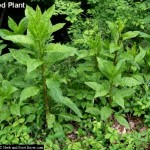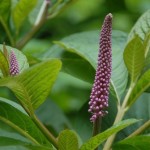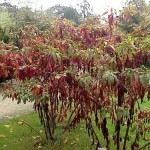Pokeweed Root – Phytolacca Americana
|
Current Demand = Normal |
Parts Used: Root & Berries |
 |
 |
 |
 |
Family: Phytolaccaceae
Common Names: Phytolacca Decandra, grubroot, inkberry, pigeon berry…
Description:
This is an American perennial shrub that likes to grow in hedges, woodlands, and waste places. It can reach up to three meters in height, but the most unusually physical feature is the large root with its irregular branches. It is a purple-stemmed, toxic herb that has fetid foliage and white or pinkish flowers, followed by green berries that ripening to dark purple and ripen in August.
Planting/Cultivation:
Growing region: Poke root can be found thru-out the United States, especially in the south but not in the extreme north. It can also be found growing in damp soils and shady places such as fence rows and waste places.
Poke root prefers soil containing lime salts. It prefers full to partial shade. It can tolerate short droughts, but really thrives with adequate watering.
Root: replanting pieces of the root in the early summer in March or October. Be sure each piece of root has one growth bud. Larger divisions can be planted directly into permanent homes. Pot smaller divisions and grow in light shade in a cold frame until well established, then transplant to permanent homes.
Seeds: self seeds readily throughout its native range. Sow seeds in autumn or spring in a cold frame.
When they are large enough to handle, prick seedlings and place in individual pots and keep in a green house the first winter. Plant them in permanent homes in late spring or early summer.
Harvesting/Drying:
Parts used: root and berries
Unearth roots in late autumn after the plant has died back for the winter. Cut into slices lengthwise or crosswise. Drying may occur either in the sun or the shade.
The root is gray in color, hard, wrinkled and fibrous. When possible dry indoors in a well ventilated barn loft or attic to protect against the elements. If natural heat is not available you may need to add heat and a fan for continuous airflow. The key to drying herbs, roots or bark is an even combination of heat and airflow.
Once the poke root is completely dry (the stem will snap not bend) place the herb carefully into a cardboard box or paper bag for storage in a dry areas until ready to sell or use. Do not store the herb in plastic as it will mold.
Attributes (Images)
By Huw Williams (Huwmanbeing) (Own work) [Public domain], via Wikimedia Commons
By Kurt Stüber [1] [GFDL or CC-BY-SA-3.0], via Wikimedia Commons
By Ericoides (Own work) [CC BY-SA 3.0], via Wikimedia Commons
 Root Buyer
Root Buyer